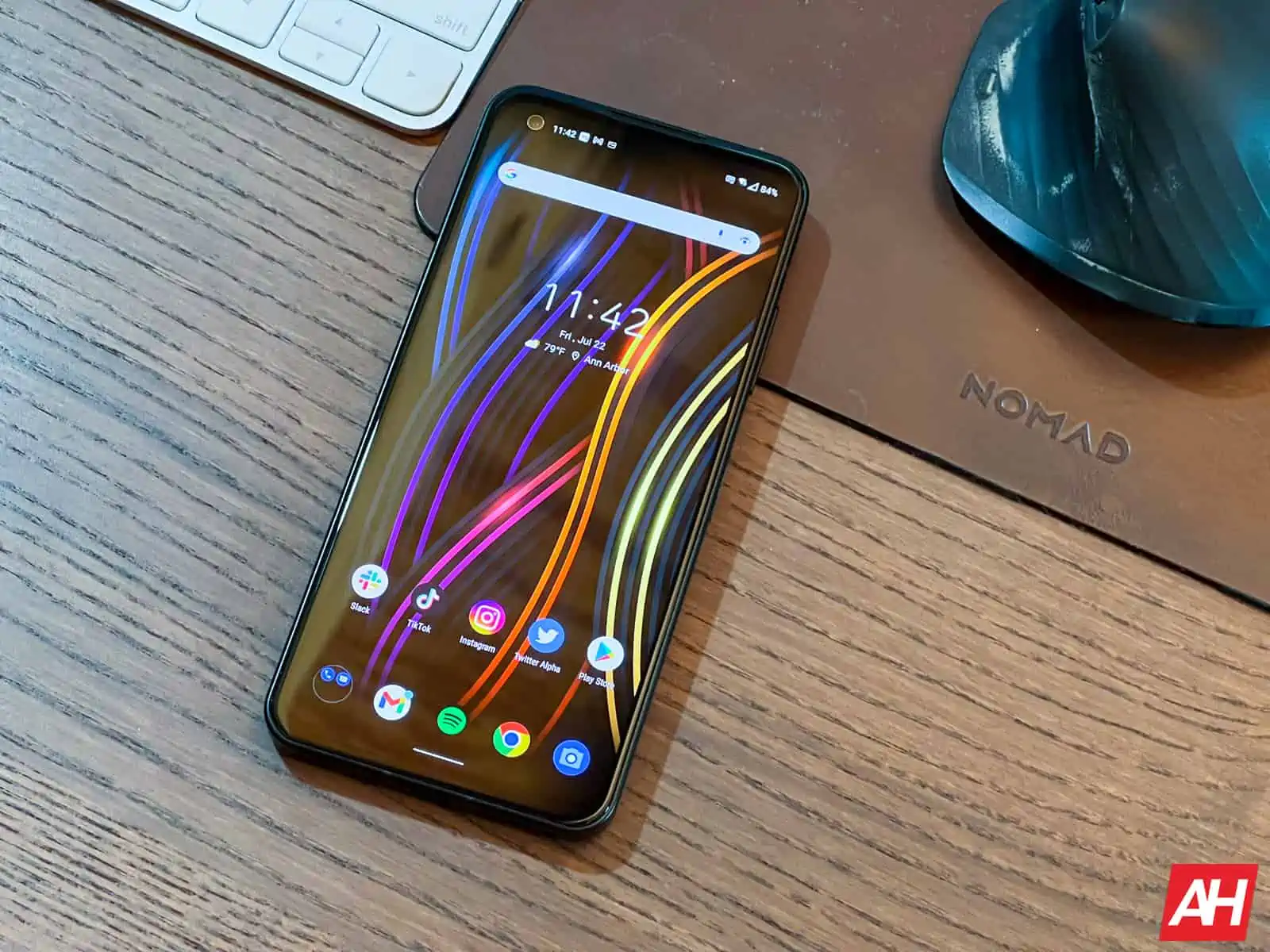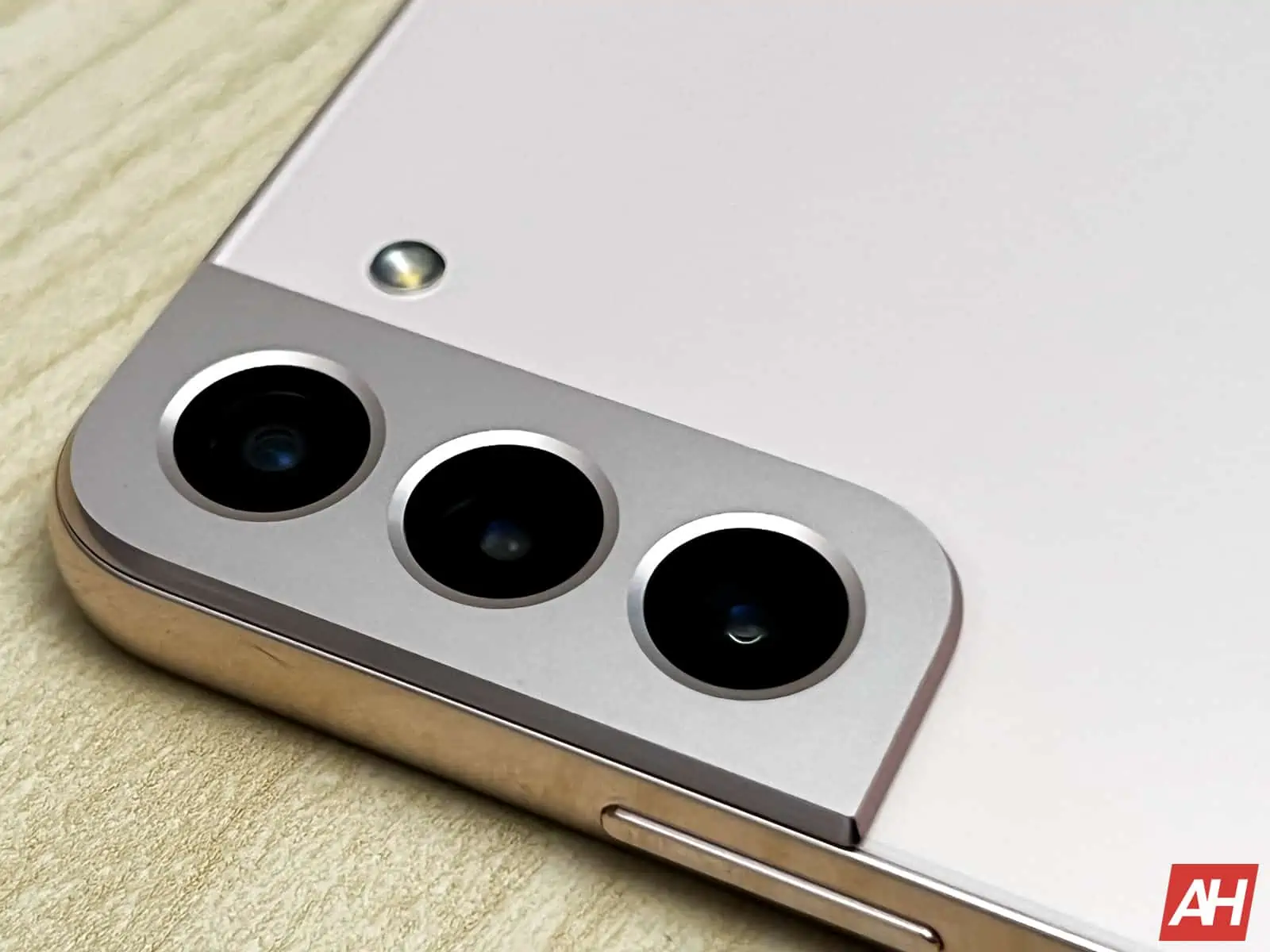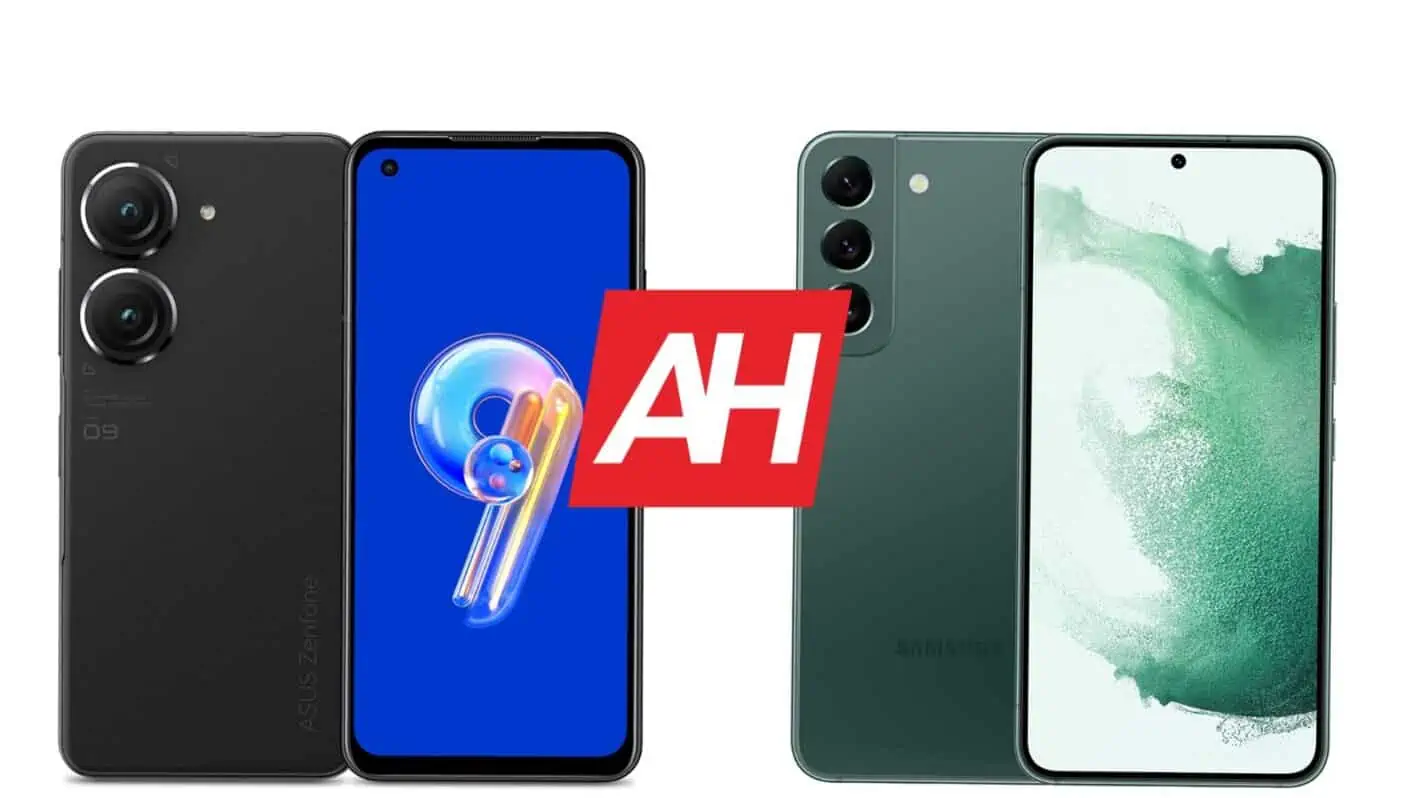If you’re looking to buy a somewhat compact flagship smartphone, there are not many choices. Luckily, there are a few, and they are quite good. In this article, we’ll compare two such phones, the ASUS ZenFone 9 vs Samsung Galaxy S22. Both of these phones were announced in 2022, but the ZenFone 9 is newer. Both of these phones are quite compact, especially in comparison to the vast majority of other offerings on the market.
As per usual, we’ll first list the specs of these two phones, and will then compare them across a number of categories. We’ll compare their designs, displays, performance, battery life, cameras, and audio performance. They do look considerably different, while their internals are also different. Their price tags are somewhat similar, though, which is another reason you may be looking into both of them.
Specs
| ASUS ZenFone 9 | Samsung Galaxy S22 | |
| Screen size | 5.9-inch FullHD+ Super AMOLED display (60-120Hz refresh rate) | 6.1-inch FullHD+ Dynamic AMOLED 2X display (120Hz adaptive refresh rate) |
| Screen resolution | 2400 x 1080 | 2340 x 1080 |
| SoC | Qualcomm Snapdragon 8+ Gen 1 | Qualcomm Snapdragon 8 Gen 1 or Samsung Exynos 2200 |
| RAM | 8GB/16GB (LPDDR5) | 8GB (LPDDR5) |
| Storage | 128GB/256GB (UFS 3.1), non-expandable | 128GB/256GB, non-expandable |
| Rear cameras | 50MP (f/1.9 aperture, 23.8mm wide-angle lens, 1.0um pixel size, gimbal OIS, PDAF) 12MP (f/2.2 aperture, 113-degree FoV, 1.4um pixel size, 14.4mm lens) |
50MP (f/1.8 aperture, 24mm lens, OIS, Dual Pixel PDAF, 1.0um pixel size) 10MP (f/2.4 aperture, 70mm lens, telephoto, 1.0um pixel size, OIS, PDAF, 3x optical zoom) 12MP (ultrawide, f/2.2 aperture, 13mm lens, 120-degree FoV, 1.4um pixel size) |
| Front cameras | 12MP (f/2.5 aperture, 1.22um pixel size, 27.5mm lens, dual pixel PDAF) | 10MP (f/2.2 aperture, 1.22um pixel size, 26mm lens, Dual Pixel PDAF) |
| Battery | 4,300mAh, non-removable, 30W wired charging (charger included) | 3,700mAh, non-removable, 45W wired charging, 15W Qi wireless charging, 5W Wireless PowerShare |
| Dimensions | 146.5 x 68.1 x 9.1mm | 146 x 70.6 x 7.6mm |
| Weight | 169 grams | 167 grams |
| Connectivity | 5G, LTE, NFC, Bluetooth 5.2, Wi-Fi, USB Type-C | 5G, LTE, NFC, Bluetooth 5.2, Wi-Fi, USB Type-C |
| Security | Side-facing fingerprint scanner | In-display fingerprint scanner (ultrasonic) |
| OS | Android 12 ZneUI |
Android 12 One UI 4.1 |
| Price | €799 | $799 |
| Buy | ASUS | Samsung |
ASUS ZenFone 9 vs Samsung Galaxy S22: Design
These two devices are very easy to differentiate, as their designs are not that similar. They both include display camera holes, but in different spots, while the Galaxy S22 has thinner bezels, even though the ZenFone 9’s are also quite thin. Flat displays are included on both phones, though. The cameras on their back have entirely different designs. The two on the ZenFone 9 come in the form of two separate camera islands. The three on the back of the Galaxy S22 are all a part of the same camera module, and are surrounded by metal.
Having said that, both phones utilize an aluminum frame. The Galaxy S22 has glass on its back, while the ZenFone 9 utilizes polymer material. Three different color variants of the ZenFone 9 each have a different iteration of polymer, though, so they feel different in the hand. One is smooth, one rough, and one is middle-of-the-road. The Galaxy S22’s glass backplate is exactly what you’d expect, considering it’s glass. That is Gorilla Glass Victus+, by the way.
The ASUS ZenFone 9 is considerably more grippy, mainly because of its backplate. It also has mostly flat sides, which helps with grip as well. The phone has been really well-designed, so it doesn’t cut into your hand or anything of the sort. The two phones are almost identically tall, but the ZenFone 9 is narrower, and thicker. They also weigh almost the same, slightly under 170 grams.
ASUS ZenFone 9 vs Samsung Galaxy S22: Display
The ZenFone 9 includes a 5.9-inch fullHD+ (2400 x 1080) Super AMOLED display. That display is flat, and it offers a 120Hz refresh rate. It does support HDR10+ content, and it gets up to 1,100 nits of peak brightness. We’re looking at a 20:9 display aspect ratio here, and around 445 ppi. The Gorilla Glass Victus is included on top of this panel, in order to protect it. A display camera hole sits in the top-left corner.

The Galaxy S22, on the other hand, features a 6.1-inch fullHD+ (2340 x 1080) Dynamic AMOLED 2X display. That panel is also flat, and it offers a 120Hz refresh rate. HDR10+ content is supported by this display as well, while this panel can reach 1,300 nits of brightness. Corning’s Gorilla Glass Victus+ protects this panel, and we’re looking at a 19.5:9 display aspect ratio with around 425 ppi. The Galaxy S22 includes a centered display camera hole.
Do note that peak brightness on both displays can be reached only in auto mode. Having said that, both of these panels are truly excellent. The viewing angles are great, and both are quite vivid. They’re more than sharp enough, and both displays are well-optimized when it comes to touch sensitivity as well. You’ll be more than happy with either one of these displays, as we really don’t have any complaints.
ASUS ZenFone 9 vs Samsung Galaxy S22: Performance
The Snapdragon 8+ Gen 1 fuels the ASUS ZenFone 9. The Galaxy S22 comes in two SoC variants, the Snapdragon 8 Gen 1 and Exynos 2200 units. The Exynos 2200 units are sold in Europe only. Both devices utilize LPDDR5 RAM and UFS 3.1 flash storage. The ZenFone 9 offers up to 16GB of RAM, while the Galaxy S22 has only one RAM variant, it offers you 8GB of RAM.
Those specs are really powerful, but what does that mean for the actual performance of these devices? Well, both companies did a good job optimization-wise. The thing is, the ZenFone 9 felt smoother in actual usage, at least in our experience. Just to be clear, we’ve used the Snapdragon 8 Gen 1 variant of the Galaxy S22 most of the time. The Exynos 2200 offered noticeably worse performance, but we didn’t get a chance to use it for long.
The Galaxy S22 does experience hiccups here and there. Even slowdowns occurred from time to time. Nothing major, but something worth noting, considering that the ZenFone 9 didn’t have such issues. The ZenFone 9 does come with much cleaner software, meaning less bloated, so that could be one of the reasons why. It also has a more powerful SoC, and it was a bit cooler in day-to-day usage. In general, though, both phones performed really well, and will be able to handle anything you throw at them.
ASUS ZenFone 9 vs Samsung Galaxy S22: Battery
The ASUS ZenFone 9 comes with a 4,300mAh battery, while the Galaxy S22 includes a 3,700mAh unit. And yes, you will feel the difference. The ZenFone 9 has much better battery life than its predecessor. We’ve been able to cross the 7-hour screen-on-time mark without a problem, on a number of occasions, and still have some battery left. Even 8 hours of screen-on-time is doable.
The Galaxy S22 can’t come close to such numbers. Around 5-5.5 hours was what we were able to get with the Snapdragon 8 Gen 1 model most of the time. At times it was able to hit 6 hours of screen-on-time. It will all depend on what you do with your phone, of course. Your usage will likely be considerably different, so your mileage may vary. We didn’t really play a lot of games with either device, so take that into consideration.
ASUS’ flagship supports 30W wired charging, and it comes with a charger in the box. It also supports reverse charging, in case you need to use it as a power bank. The Galaxy S22, on the flip side, supports 25W wired charging, 15W wireless charging, and 4.5W reverse wireless charging. Do note that Samsung’s device does not include a charger in the box, though, you’ll need to buy one, if you don’t have one at home.
ASUS ZenFone 9 vs Samsung Galaxy S22: Cameras
The ZenFone 9 includes two cameras, while the Galaxy S22 has three on the back. A 50-megapixel main camera is combined with a 12-megapixel ultrawide camera on the ZenFone 9. The Galaxy S22 has a 50-megapixel main camera, a 10-megapixel telephoto unit, and a 12-megapixel ultrawide camera. So, is the camera performance any good on these two phones? Long story short, yes, but these are not the best camera smartphones around.

The ZenFone 9 managed to surprise us with its camera performance. ASUS improved a lot of things compared to the ZenFone 8, and the ZenFone 9 does a better job than the ROG 6, despite the fact it has the same main camera. The ZenFone 9 shoots vivid images, with plenty of detail, and it does a good job in low light as well. It leans towards Pixel style with its colors. The phone’s cameras handle HDR situations well, though you may need to use touch to focus from time to time to get the perfect shot. It also does a great job of keeping the same color science between its main and ultrawide cameras.
The Galaxy S22 has really good camera performance as well. It also leans towards vivid shots, with plenty of saturation. It does a good job in low light, though the difference between its main and ultrawide cameras are apparent when you look at the colors. When it comes to telephoto shots, the Galaxy S22 is the better of the two, which is logical considering that the ZenFone 9 doesn’t have a telephoto camera.
Many people would say that the Galaxy S22 shoots better photos just because of its name, but you’d be surprised at the results. Both are immensely capable in the camera department, and the ZenFone 9’s gimbal OIS definitely helps with both images and video.
Audio
Not many flagship phones include an audio jack these days, well, the ZenFone 9 does. ASUS managed to find space for it inside of this rather compact body. The Galaxy S22 does not, however. Both phones do have stereo speakers, though, and both support Bluetooth 5.2 as well.
Are the speakers on these two phones any good? Well, yes, they are. Both offer punchy sound, which is well-balanced, and vocals are clear in both cases. There is even some bass in both sets of speakers. Both sets are sufficiently loud, and chances are most people will be happy with either pair.

